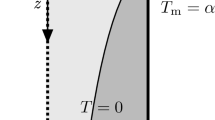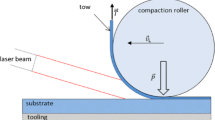Abstract
In this work, a new second-order conservative finite volume scheme using the cell-to-vertex interpolation is proposed to solve the heat transfer problem involving discontinuous solution and discontinuous materials properties. We apply the method to a thermoplastic extrusion process where a dry calibration is used to cool down a polymer tape. One of the major difficulties in the modelling is to prescribe the adequate value for the heat transfer coefficient between the polymer and the calibrator. To this end, we define an optimization procedure coupled with the new finite volume method to evaluate the heat transfer coefficient at the polymer–calibrator interface from experimental data.


















Similar content being viewed by others
References
Michaeli W (2003) Extrusion dies for plastics and rubber 3E: design and engineering computations. Hanser, Munich
Sastrohartono T, Jaluria Y, Esseghir M, Sernas V (1995) A numerical and experimental study of the three-dimensional transport in the channel of an extruder for polymeric materials. Int J Heat Mass Transf 36:1957–1973
Rauwendaal C (2014) Polymer extrusion 5E. Hanser, Munich
Rauwendaal C (2010) Understanding extrusion 2E. Hanser, Munich
Mousseau P, Delaunay D, Lefvre N (2009) Analysis of the heat transfer in PVC profiles during the extrusion calibration/cooling step. Int Polym Process 24:122–132
Carneiro OS, Nóbrega JM, Mota AR, Silva C (2013) Prototype and methodology for the characterization of the polymer-calibrator interface heat transfer coefficient. Polym Test 32(6):1154–1161
Nóbrega JM, Carneiro OS, Covas JA, Pinho FT, Oliveira PJ (2004) Design of calibrators for extruded profiles. Part I: modeling the thermal interchanges. Polym Eng Sci 44(12):2216–2228
Mitsoulis E, Vlachopoulos J, Mirza FA (1984) Finite element analysis of flow through dies and extruders channels. SPE ANTEC Tech Pap 30:53–58
Gupta M, Kown T, Jaluria Y (1992) Multivariant finite element for the three-dimensional simulation of viscous incompressible flows. Int J Numer Meth Fluids 14:557–585
Yu Y, Luo X (2015) Estimation of heat transfer coefficients and heat flux on the billet surface by an integrated approach. Int J Heat Mass Transf 90:645–653
Murashov MV, Panin SD (2015) Numerical modelling of contact heat transfer problem with work hardened rough surfaces. Int J Heat Mass Transf 90:72–80
Versteeg H, Malalasekera W (2007) An introduction to computational fluid dynamics: the finite volume method, 2nd edn. Pearson Education, ISBN:978-0-13-127498-3
Xue S-C, Barton GW (2012) Implementation of boundary conditions and global mass conservation in pressure-based finite volume method on unstructured grids forfluid flow and heat transfer simulations. Int J Heat Mass Transf 55:5233–5243
Reséndiz-Flores EO, García-Calvillo ID (2014) Application of the finite pointset method to non-stationary heat conduction problems. Int J Heat Mass Transf 71:720–723
Reséndiz-Flores EO, Saucedo-Zendojo FR (2015) Two-dimensional numerical simulation of heat transfer with moving heat source in welding using the finite pointset method. Int J Heat Mass Transf 90:239–245
Costa R, Clain S, Machado GJ (2014) New cell-vertex reconstruction for finite volume scheme: application to the convection–diffusion–reaction equation. Comput Math Appl 68:1229–1249
Costa R, Clain S, Machado GJ (2014) Finite volume scheme based on cell-vertex reconstructions for anisotropic diffusion problems with discontinuous coefficients. In: 14th international conference in computational science and its applications—ICCSA (2014) Guimares, Portugal, 30 de junho a 3 de julho de 2014. Lecture Notes in Computer Science 8579:87–102
Uffrecht W, Heinschke B, Günther A, Caspary V, Odenbach S (2015) Measurement of heat transfer coefficients at up to 25,500 g—a sensor test at a rotating free disk with complex telemetric instrumentation. Int J Therm Sci 96:331–344
Rausch RD, Batina JT, Yang HTY (1991) Spatial adaptation procedure on unstructured meshes for accurate unsteady aerodynamic flow computation, AIAA Paper 91–1106
Frink NT (1991) Three-dimensional upwind scheme for solving the Euler equations on unstructured tetrahedral grids, Ph. D Dissertation, Virginia Polytechnic Institute and state university
Frink NT (1992) Upwind scheme for solving the Euler equations on unstructured tetrhedral meshes. AIAA J 1:70–77
Frink NT (1994) Recent progress toward a three-dimensional unstructured Navier–Stokes flow solver, AIAA Paper 94–0061
Mavriplis DJ (2003) Revisiting the least-squares procedure for gradient reconstruction on unstructured meshes, NASA/CR-2003-212683 NIA Report No. 2003 06
Chandrashekar P, Garg A (2013) Vertex-centroid finite volume scheme on tetrahedral grids for conservation laws. Comput Math Appl 65:58–74
Acknowledgements
This research was financed by FEDER Funds through Programa Operacional Factores de Competitividade — COMPETE and by Portuguese Funds through FCT — Fundação para a Ciência e a Tecnologia, within the Projects PEst-OE/MAT/UI0013/2014, PTDC/MAT/121185/2010, and UID/CTM/50025/2013. The second author was also financed by project FCT-ANR/MAT-NAN/0122/2012.
Author information
Authors and Affiliations
Corresponding author
Rights and permissions
About this article
Cite this article
Marques, F., Clain, S., Machado, G.J. et al. A new energy conservation scheme for the numeric study of the heat transfer in profile extrusion calibration. Heat Mass Transfer 53, 2901–2913 (2017). https://doi.org/10.1007/s00231-017-2023-6
Received:
Accepted:
Published:
Issue Date:
DOI: https://doi.org/10.1007/s00231-017-2023-6




